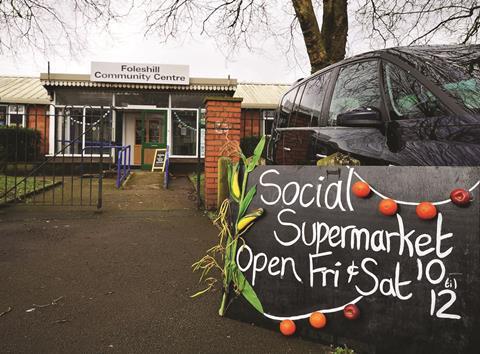As the cost of living crisis continues to bite, Tim Wyatt takes a closer look at the rise of social supermarkets

The scene is familiar and yet different. Queues of people file into a community centre or a church hall. There are tins of baked beans and packets of pasta piled high. Cheerful volunteers bustle around, greeting regulars and taking details from newcomers. In one corner, a Citizens Advice banner has been unfurled.
But this is not one of the hundreds of foodbanks that have sprung up over the past ten years. It’s known by lots of different names – social supermarket, community larder, local pantry – but the fundamental idea is the same, and it’s spreading fast. More and more churches and Christian charities are opening these projects to feed their neighbours, tackle poverty, reduce food waste and hopefully bring marginalised people into a kingdom-focused community.
Huge discounts
Social supermarkets act like small shops, offering food at a fraction of the normal price. Most run on a membership-basis – you pay a few pounds a week (depending on the size of your household), which entitles you to a number of items or bags of food. The produce is often from supermarket surplus, otherwise headed to landfill. Typically, a membership allows you to buy £30 of food for less than 10 per cent of the normal price.
While the concept of social supermarkets has been around for years, they’ve soared in popularity since the Covid-19 pandemic which, coupled with the war in Ukraine, soaring energy prices and record inflation, have pushed millions more Britons to the brink of food poverty. According to the Food Standards Agency, 15 per cent of the UK population is now ‘food insecure’, with one in four skipping meals or reducing portion size because of the cost of food.
Dignity
Rev Tom Murray runs the Cutteslowe Community Larder, a social supermarket on a council estate in Oxford where his church is also based. As well providing food at up to a 90 per cent discount, his larder also reduces local food waste, and has built a community that now flows over into other projects. “The food is the thing that draws people in, but actually a lot of it is [about] wraparound services. You’re not just meeting a need, you’re also trying to tackle some of the underlying reasons for food poverty.”
The social supermarket is open to anyone who can afford the £3.50 weekly membership. This means it attracts those in severe poverty up to literal millionaires concerned about food going into landfill. “It changes the flavour and the feel of a larder, because nobody can say why a person is there,” Murray explained. “Some people turn up in their Porsche and pick up leftover potatoes. But they pay their membership like everyone else. You can’t make assumptions, which brings a real dignity.”
The importance of dignity comes up often when speaking with those running social supermarkets. It was the watchword for Church Action on Poverty, which sponsors a growing network of Local Pantries across the country. James Henderson, who heads up the project, said a volunteer in Peckham, south London, coined the mantra: “Dignity, hope and choice”. “That’s what a pantry really gives,” he said.
“If something feels like charity, that can be a barrier in many cases. But paying a small membership fee really helps to lower those barriers.” As a result, pantry members are often evangelical when it comes to sharing the concept with friends and family, unlike the stigma they often feel when relying on a foodbank.
Supply problems
Sam Milchem, who runs a social supermarket for Soul Church in Norwich noted that their church’s previous model of alleviating food poverty had drawbacks. Food parcels used to be given to every household on their pandemic-era food distribution scheme, irrespective of individual circumstances, so people with gluten intolerances were being given kilos of pasta they couldn’t eat, week after week.
At a social supermarket, however, members can pick out the food they actually want, just as they would do in any other shop. As a result, there is much less wastage, and the total amount needed to feed the thousand or so households who are members is far less.
Most social supermarkets source their food from national charities, such as FareShare, who are donated surplus but still edible products from supermarkets to pass on free, or at very low cost. At the height of the pandemic, there were enormous quantities of food coming through this route, but as the cost of living crisis has taken hold, supermarkets have tightened their belts, reducing their own waste considerably.
We’re nowhere near the worst of this cost of living crisis, this is just the start of it
Milchem said FareShare used to provide up to 30 tons of food a week, but that has now plummeted to just 800kg. His social supermarket still needs around 2.5 tons to feed its members. “I haven’t yet had to close, and that is a miracle by the grace of God. But our big fear is we will get to a point where we can’t help people because we run out of food.”
A similar problem at the Cutteslowe Community Larder means its policy of welcoming all, regardless of income, has become more complicated. During Covid, it was easy to give discounted food to everyone because it would have simply been thrown away otherwise, Murray said. “I feel a little more uncomfortable about it now, because the amount of excess food coming out of supermarkets is reducing.”
He has continued to resist means-testing the larder because that would undermine its ability to build a resilient and self-supporting community. The greater the diversity of the membership, the more the members are able to help each other, he said. Some grow vegetables to bring each week, while others organise benefits advice or second-hand school uniform sales.
Physical and spiritual hunger
Henderson, from Church Action on Poverty agreed: “We have this sense that it’s all about the food, but it’s not.” Providing food brought members into the pantry but, once there, they also gained access to relationships that helped move them towards getting back into work or gaining new skills.
In Norwich, the community wanted to see spiritual transformation too. Milchem said he and his team ultimately ran the social supermarket because they believed Jesus was the solution to their members’ deepest needs. “Jesus time and time again feeds people…but then he teaches them. No one’s going to want to listen to me talk about how Jesus says ‘You can have life to the full’ if they’re saying: ‘I would really just love a loaf of bread, or some chicken.’ So I think we’re called to do both.”
He had several stories to share of families who had first joined as members of the original lockdown food delivery project but, through building relationships, had become Christians, got back into work and started volunteering themselves.
Murray agreed, noting the delicate balance required with these kind of social outreach schemes. He longed to draw his larder members into church fellowship and to introduce them to Jesus, but was wary of exploiting vulnerable people who had primarily come for affordable food. He hoped this would happen organically, but was now exploring more intentional options for sharing the gospel with those within the larder community, such as an evening meal cooked from larder ingredients where members could discuss faith.
All of those interviewed said demand was rising for social supermarkets. In Oxford, the community larder’s membership has grown from 50 at the start in 2020 to 140 today. Church Action on Poverty’s pantry network has exploded in size. With just 14 pantries before Covid-19, today they have 75 and are planning to increase to 225 in the next three years.
OUR BIG FEAR IS WE WILL GET TO A POINT WHERE WE CAN’T HELP PEOPLE BECAUSE WE RUN OUT OF FOOD
Milchem said his social supermarket currently served 1,000 households and, because of the growing struggles many had at present, they had introduced job clubs, debt advice, mental health groups and other courses. “What I’m really noticing is an increase in the working families that are trying to get to the larder,” Murray said. “We’re nowhere near the worst of this cost of living crisis, this is just the start. And I think, sadly, it’s going to get quite a lot worse before it gets better.”
A final difference between social supermarkets and foodbanks is their long-term vision. Those running foodbanks have often said their dream would be to shut the whole thing down, because nobody in a developed nation should need access to a foodbank. But social supermarkets, focused on cutting food waste and fostering community, are not necessary evils but actively good things. “Once people start to build that hope, they can start to make choices for themselves,” Henderson said. “And pantries are a great springboard for that.” It was quite common for pantry members to continue popping in to visit and volunteer even after they no longer needed help affording food. “They don’t actually need the shop, but they want somebody else to be able to have that. That’s really exciting to see.”





































No comments yet